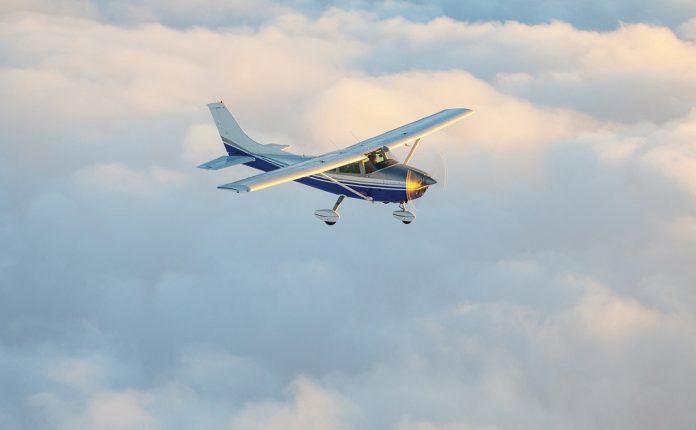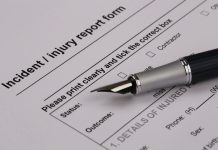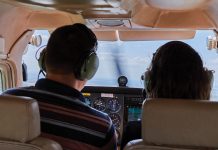Propeller strike is expensive, embarrassing, but not inevitable.
The phrase ‘prop strike’ will make any aviator’s gut wrench – from the sound, shock of impact or repair costs. There’s no silver lining to a propeller incident.
It is essential for every pilot to understand what constitutes a prop strike, the potential consequences and the steps to take after the incident.
How to respond to a prop strike
Todd Pennifold, general manager at Southern Propeller Services, says: ‘A foreign object strike to your propeller can include a broad spectrum of damage, from a minor stone nick to severe damage.’
He says the strike may cause blades to become loose in the hub, damage pitch change mechanisms, bend blades and damage and crack propeller hub assemblies; not to mention that load transfer from the blades during a strike is transferred towards the hub assembly.
No part of this is a good situation. Anytime you’re unsure about what has happened, but you suspect a blade strike, shut down and inspect the blades. Avoid taxiing the aircraft. Do a preliminary inspection for signs of strike or damage, write up the suspected strike and have engineering take care of the assessment, repair and return to service.
‘A conservative approach in evaluating the damage is required because there may be hidden damage that’s not readily apparent during a visual inspection,’ Pennifold says.
You must document the incident and report it to the relevant authorities, such as an entry on the maintenance release and a report to the aircraft operator. Engineers will need to evaluate the aircraft’s condition and do any repairs needed, before it flies again.
Meanwhile, Grade 1 instructor Enzo Lacono at the Aerobatic School, offers this advice to pilots. ‘If you strike on the ground, do not take-off – simply shut down the engine as soon as possible.’
He recommends a three-point take-off for tailwheel aeroplanes with large blades, instead of raising the tailwheel before rotating. He says a three-point attitude will also be required on landing to avoid a prop strike.
‘If you make impact [by the prop] with the ground on landing, do not take off again, as you may give yourself an engine failure due to high vibrations from imbalanced prop blades,’ he says. ‘Instead, land safely and stop engine rotation immediately to avoid further damage to engine components.’
What constitutes a prop strike?
Propeller companies have 3 categories for a foreign object making contact with a propeller. McCauley’s Service Bulletin 176E outlines them as:
Object strike: defined as the impact of a non-rotating propeller by a moving object, such as a ground power unit. Procedures for an object strike include inspecting for damage such as scrapes, gouges, etc., caused by the impact. Any damage beyond normal field repair limits (defined in other McCauley service information) is cause for propeller removal and repair.
Blade strike of rotating propeller: Blade strike, sometimes referred to as ground strike, is defined as any impact or suspected impact of the rotating propeller on such items as, but not limited to, the ground, tow bars, landing lights, carts, snowbanks, hedges, etc. Any blade bent beyond repair limits must be scrapped.
Bird strike: involves any bird collision with the rotating propeller. Post-strike, a McCauley propeller requires inspection based on specified criteria for airworthiness.
Hartzell Propeller Inc Service Bulletin 61Y states, ‘Propellers exposed to impact damage, lightning strikes or overspeed must be inspected in accordance with the Special Inspections chapter of Hartzell Standard Practices Manual 202A (61-01-02) before return to service.’ In other words, if something goes wrong with the prop – or even if you suspect it – don’t fly.
Considering the propeller is one aspect, but what about the engine? Before the mid-1960s, following a blade strike, the crankcase wasn’t opened and inspected. Instead, a dial-indicator test was conducted on the crankshaft end to determine if it was bent. However, this approach is now considered insufficient and requires a bulk strip.
What’s a bulk strip? CASA defines it as ‘the partial disassembly of the engine for the purpose of inspection or repair; the extent of which requires the separation of the crankcase parting flange or removal of the crankshaft’. And yes, it is costly. But you may want to consider the alternative – a catastrophic prop failure in flight or during take-off when the engine operates at maximum power.
For this very reason, engine manufacturers unanimously advocate for a comprehensive approach: any damage requiring propeller repair necessitates pulling the engine for a thorough inspection.
As per Lycoming’s Mandatory Service Bulletin 533A, ‘A propeller strike can occur at taxi speeds and during touch-and-go operations with propeller tip ground contact. In addition, propeller strikes also include situations where an aircraft is stationary and a landing gear collapses, causing one or more blades to be bent, or where a hangar door (or other object) hits the propeller blade. These instances are cases of sudden engine stoppage because of potentially severe side loading on the crankshaft propeller flange, front bearing, and seal.’
The bulletin further explains that in any of these cases, ‘The safest procedure is to remove and disassemble the engine and completely inspect the reciprocating and rotating parts, including crankshaft gear and dowel parts. Any decision to operate an engine involved in a [prop strike] without such inspection must be the responsibility of the agency returning the aircraft to service.’
Similarly, Teledyne Continental Engines’ (TCE) Service Bulletin SB96-11 says, ‘Following any propeller strike, complete disassembly and inspection of all rotating engine components is mandatory and must be accomplished before further flight. Inspect all engine-driven accessories in accordance with the manufacturer’s maintenance instructions.’
That said, the one minor out for aircraft operators that TCE asserts is, ‘For instances where the propeller is damaged by a small foreign object during operation, such as a small stone, inspection and repair must be accomplished in accordance with the propeller manufacturer’s published instructions. Any time foreign object damage requires propeller removal for repairs other than minor dressing of the blades, the incident is considered a propeller strike and must be inspected.’
Why don’t you skip the prop overhaul?
Whether you’ve had a prop strike or not, the care and maintenance of your propeller are essential for aviation safety, compliance, and optimal performance. Regular maintenance addresses wear, detects hidden issues, and ensures structural integrity.
Overhauls contribute to aircraft longevity, meeting insurance requirements and a safer and more efficient flying experience.
Pennifold says, ‘A propeller overhaul matters because it is one of the most highly stressed components on an aircraft. The centrifugal force on a blade is over 18 tonnes and, together with thrust bending, flexing, and aerodynamic twisting loads, the scheduled propeller inspection is crucial.’
In addition to such pressures, you have the effects of exposure to the environment over a period, which creates a need for propeller overhaul regardless of flight time. Corrosion can create hidden defects in critical blade retention components, as Hartzell’s Service Letter 61Y stipulates.
Sensenich Propellers considered poor maintenance and damage to include ‘leading edge nicks and cuts, face nicks and cuts or corrosion that are left unrepaired and or painted over without proper removal and re-application of a corrosion coating.’
Following any propeller strike, complete disassembly and inspection of all rotating engine components is mandatory.
What to expect from a propeller overhaul
The overhaul process is complex and is usually around 4–6 weeks, depending on the pre-existing condition of your prop – and that can feel like an awfully long time for a pilot to be grounded.
However, once you understand the meticulous (and interesting) overhaul process – you’ll appreciate the TLC that the prop maintenance crew awards your propeller. After all, it’s the crux of what gives man wings.
A prop overhaul can be broken into these main phases: disassembly, cleaning, inspection, repair and reassembly.
Once the shop receives your propeller, it undergoes disassembly, with each component documented, stripped and subjected to appropriate cleaning procedures.
The dimensions of propeller parts are measured against specified tolerances, and a thorough inspection is conducted using dye penetrant and other techniques that identify potential cracks or damage.
A test is carried out for a propeller with composite blades to determine any de-lamination in the composite material and leading edges. The propeller is stripped and cleaned.
Composite propeller blades are known for being lightweight and contribute to improved fuel efficiency and overall aircraft performance. Additionally, composite materials provide excellent resistance to corrosion and fatigue, enhancing the durability and lifespan of the blades. They often exhibit superior aerodynamic efficiency, leading to reduced noise levels and vibrations during flight.
Pennifold says, ‘In the case of a propeller with aluminium blades, the blades’ dimensions are measured to determine serviceability.’
‘All propeller parts are visually inspected, and non-destructive testing is carried out on specific parts, including the hub and blades.’
Blade profiling is undertaken to eliminate surface impairments and restore the correct shape and aerofoil while additional components are substituted or mended as required.
‘Aluminium blades and hub are coated with corrosion protection and then repainted,’ he says. ‘Composite blades are sanded and inspected. If required, leading edges are replaced. The propeller is then re-assembled, functionally tested and statically balanced.’
The static balance prevents any imbalance in blade weights. Additionally, dynamic balancing is recommended after the propeller is mounted and reinstalled on the aircraft. Dynamic balancing entails assessing the vibrations of the entire propeller and engine assembly during operation. Opting for dynamic balancing assists in minimising cabin vibration and in-flight noise, and therefore, reduction in fatigue or damage to systems or structures through reduced vibration. It’s important to note that not all propeller service providers offer dynamic balancing due to the specialised equipment, tools, and training required.
After that’s complete, your LAME will hand over a logbook entry and a time since overhaul (TSO) of zero. Not to mention a shiny new prop.
Conclusion
From a pilot’s point of view, the issue is not only a ground strike, but damage – or suspected damage – from rocks, birds or other objects. If this occurs, an entry is made on the maintenance release – the aircraft cannot be flown until this defect is cleared by a LAME. Pilots should not take matters into their own hands and use a metal file to remove nicks or chips – this should be done by a LAME.
Propeller care
Eight best practice tips:
- Avoid manoeuvring the aircraft by the propeller blades, use the tow bar – always treat the prop as ‘live’.
- Don’t skip your prop during pre-flight inspections.
- Do not touch propeller blades without checking the magnetos are off!
- Monitor leading edges. Ensure they’re in good condition with proper paint coverage and no stone nicks.
- Monitor for unusual prop vibrations during run-ups and in-flight.
- Ensure there are no loose blades in the hub.
- There should be no grease or oil leaking from the propeller.
- A qualified engineer should file any blade damage.
Five prop ground rules
Moving an aircraft by pulling or pushing the blades is generally not recommended, for several reasons:
1. Safety concerns
‘Propellers are designed to generate thrust and lift, not to push or pull the entire weight of an aircraft on the ground,’ Lacono says. Attempting to move an aeroplane by pushing on the blades can pose serious safety risks, including the risk of injury to people nearby.
2. Structural integrity
Aeroplanes are designed to withstand aerodynamic forces generated during flight, not the mechanical stresses associated with ground movement. ‘Neither the engine nor the prop benefit from the loads imposed by horsing the whole airplane around,’ Lacono says. Attempting to move an aircraft by hand may subject the landing gear and other structural components to forces they were not designed to handle, potentially leading to damage.
3. Precision control
Aircraft movement on the ground requires precise control, typically achieved by using ground handling equipment (e.g. tow bars, tugs or tractors). Attempting to move an aircraft by turning the propeller lacks the precision to navigate around obstacles or park safely.
4. Risk of unintended engine start
Manually turning the prop may lead to the rotation of the engine’s crankshaft which, under certain conditions, could result in an unintended engine start. This would pose a serious safety hazard to anyone close by.
5. Manufacturer recommendations
Aircraft manufacturers provide specific guidelines for ground handling and movement to ensure the safety and integrity of the aircraft. Deviating from these recommendations may void warranties or compromise safety.





